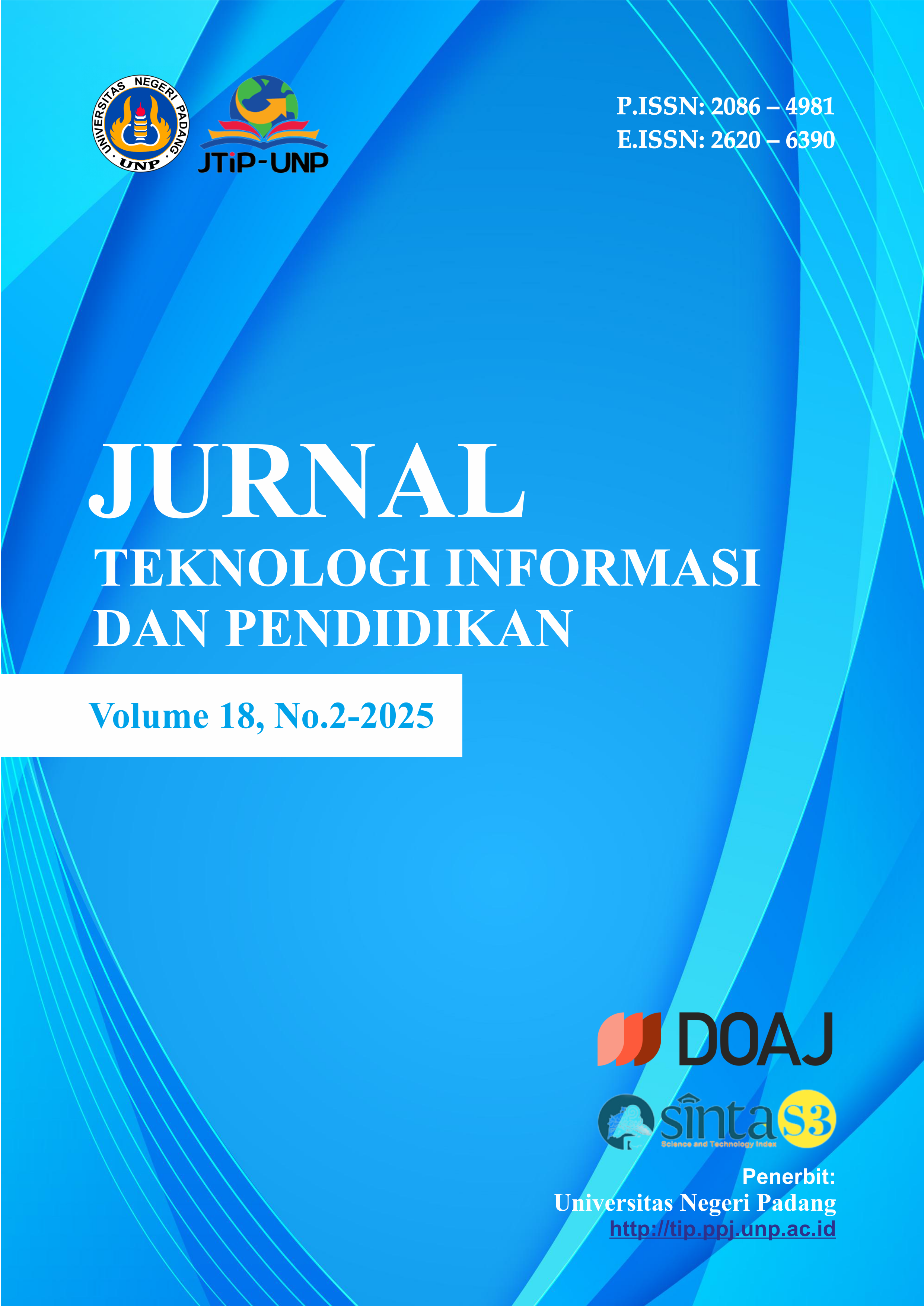Understanding BDA-AI Adoption in E-Commerce: An Integrated Framework of TOE and Technology Acceptance
DOI:
https://doi.org/10.24036/jtip.v18i2.1061Keywords:
Big Data Analytics and Artificial Intelligence, Technology-Organization-Environment, Technology Acceptance Model, Satisfaction, Continuous IntentionAbstract
This study develops an integrated theoretical framework examining the adoption and acceptance of Big Data Analytics and Artificial Intelligence (BDA-AI) in e-commerce environments. By synthesizing the Technology-Organization-Environment (TOE) framework with the Technology Acceptance Model (TAM), this research examines how technological and environmental contexts influence the adoption of BDA-AI and subsequent user behavior. The framework proposes that contextual factors affect BDA-AI implementation, which in turn influences users’ perceived ease of use and perceived usefulness. These perceptions, along with user satisfaction, ultimately determine the intention to continue using BDA-AI-enabled e-commerce platforms. Through a comprehensive literature review spanning 2014-2025, this study establishes theoretical foundations for understanding AI adoption patterns in digital commerce. The research contributes to existing literature by: (1) conceptualizing BDA-AI as a unified technological construct, examining the interplay between external contexts and user acceptance factors, (2) providing a validated research instrument for future empirical investigations. For practitioners, this study offers strategic insights into implementing AI solutions that enhance user experience while maintaining competitive advantage in digital marketplaces.
References
A. Lutfi et al., "Drivers and impact of big data analytic adoption in the retail industry: A quantitative investigation applying structural equation modeling," Journal of Retailing and Consumer Services, vol. 70, p. 103129, 2023.
C.-T. Chen, S.-C. Chen, A. Khan, M. K. Lim, and M.-L. Tseng, "Antecedents of big data analytics and artificial intelligence adoption on operational performance: the ChatGPT platform," Industrial Management & Data Systems, 2024.
A. Rashid, N. Baloch, R. Rasheed, and A. H. Ngah, "Big data analytics-artificial intelligence and sustainable performance through green supply chain practices in manufacturing firms of a developing country," Journal of Science and Technology Policy Management, 2024.
C.-T. Chen, S.-C. Chen, A. Khan, M. K. Lim, and M.-L. Tseng, "Big data analytics-artificial intelligence and supply chain ambidexterity impacts on corporate image and green communication," Industrial Management & Data Systems, 2024.
C.-T. Chen, A. Khan, and S.-C. Chen, "Modeling the impact of BDA-AI on sustainable innovation ambidexterity and environmental performance," Journal of Big Data, vol. 11, no. 1, pp. 1-28, 2024.
X. Wang, H. Pang, M. P. Wallace, Q. Wang, and W. Chen, "Learners’ perceived AI presences in AI-supported language learning: A study of AI as a humanized agent from community of inquiry," Computer Assisted Language Learning, vol. 37, no. 4, pp. 814-840, 2024.
A.-M. Stjepić, M. Pejić Bach, and V. Bosilj Vukšić, "Exploring risks in the adoption of business intelligence in SMEs using the TOE framework," Journal of Risk and Financial Management, vol. 14, no. 2, p. 58, 2021.
Y. Xu, Y. Wang, A. Khan, and R. Zhao, "Consumer Flow Experience of Senior Citizens in Using Social Media for Online Shopping," Frontiers in psychology, vol. 12, 2021.
H. Zhao and A. Khan, "The Students' Flow Experience With the Continuous Intention of Using Online English Platforms," Frontiers in Psychology, vol. 12, pp. 807084-807084, 2021.
A. Mehrabian and J. A. Russell, An approach to environmental psychology. the MIT Press, 1974.
G. Nevi, L. Pizzichini, A. Bastone, and L. Dezi, "Adoption of AI by micro and small health enterprises: effects of entrepreneurial orientation on the TOE model," European Journal of Innovation Management, 2025.
I. O. Asante, Y. Jiang, and X. Luo, "Leveraging Online Omnichannel Commerce to Enhance Consumer Engagement in the Digital Transformation Era," Journal of Theoretical and Applied Electronic Commerce Research, vol. 20, no. 1, p. 2, 2024.
S. Wang et al., "BIG DATAANALYTICS-ARTIFICIAL INTELLIGENCE, AMBIDEXTERITY, AND GREEN SUPPLYCHAIN MANAGEMENT: IMPLICATIONS ON RESPONSIBLE ECONOMY," Revista de Administração de Empresas, vol. 65, no. 1, pp. 1-20, 2025.
A. wael AL-khatib, "Drivers of generative artificial intelligence to fostering exploitative and exploratory innovation: A TOE framework," Technology in Society, vol. 75, p. 102403, 2023.
F. D. Davis, "Perceived usefulness, perceived ease of use, and user acceptance of information technology," MIS quarterly, pp. 319-340, 1989.
D. Y. Park and H. Kim, "Determinants of intentions to use digital mental healthcare content among university students, faculty, and staff: motivation, perceived usefulness, perceived ease of use, and parasocial interaction with AI Chatbot," Sustainability, vol. 15, no. 1, p. 872, 2023.
N. Yao and Q. Wang, "Factors influencing pre-service special education teachers’ intention toward AI in education: Digital literacy, teacher self-efficacy, perceived ease of use, and perceived usefulness," Heliyon, vol. 10, no. 14, 2024.
M. Talha, F. Nasreen, L. Farooq, and D. Fatima, "Evaluating The Perceived Usefulness And Ease Of Adoption Of Artificial Intelligence Tools In Teaching," Journal of Social Signs Review, vol. 3, no. 05, pp. 340-352, 2025.
S. H. Alshammari and E. Babu, "The mediating role of satisfaction in the relationship between perceived usefulness, perceived ease of use and students’ behavioural intention to use ChatGPT," Scientific Reports, vol. 15, no. 1, p. 7169, 2025.
A. Lu et al., "The roles of mobile app perceived usefulness and perceived ease of use in app-based Chinese and English learning flow and satisfaction," Education and Information Technologies, vol. 27, no. 7, pp. 10349-10370, 2022.
V. Venkatesh, M. G. Morris, G. B. Davis, and F. D. Davis, "User acceptance of information technology: Toward a unified view," MIS quarterly, pp. 425-478, 2003.
M. Amin, S. Rezaei, and M. Abolghasemi, "User satisfaction with mobile websites: the impact of perceived usefulness (PU), perceived ease of use (PEOU) and trust," Nankai Business Review International, vol. 5, no. 3, pp. 258-274, 2014.
S. Yan, L. G. Eng, and L. C. Seong, "Influencing Factors of Continuous Intention to Use E-learning System of Undergraduates in Guangxi, China: The Mediating Role of Perceived Ease of Use and Perceived Usefulness," SAGE Open, vol. 14, no. 4, p. 21582440241305231, 2024.
R. Basuki, Z. J. H. Tarigan, H. Siagian, L. S. Limanta, D. Setiawan, and J. Mochtar, "The effects of perceived ease of use, usefulness, enjoyment and intention to use online platforms on behavioral intention in online movie watching during the pandemic era," Petra Christian University, 2022.
T. C. Dam, "The influence of utilitarian value, hedonic value, and online review on consumers’ satisfaction, trust, and repurchasing intention in e-commerce platforms," Innovative Marketing, vol. 21, no. 2, p. 105, 2025.
M. Al Amin, A. M. Muzareba, I. U. Chowdhury, and M. Khondkar, "Understanding e-satisfaction, continuance intention, and e-loyalty toward mobile payment application during COVID-19: An investigation using the electronic technology continuance model," Journal of Financial Services Marketing, vol. 29, no. 2, pp. 318-340, 2024.
P. Goel, S. Parayitam, A. Sharma, N. P. Rana, and Y. K. Dwivedi, "A moderated mediation model for e-impulse buying tendency, customer satisfaction and intention to continue e-shopping," Journal of Business Research, vol. 142, pp. 1-16, 2022.
A. Ruangkanjanases, A. Khan, O. Sivarak, U. Rahardja, and S.-C. Chen, "Modeling the Consumers’ Flow Experience in E-commerce: The Integration of ECM and TAM with the Antecedents of Flow Experience," SAGE Open, vol. 14, no. 2, p. 21582440241258595, 2024.
A. Ardiyanti and E. Susilowati, "Perceived Usefulness and Technology Readiness Mediate Perceived Ease of Use and Digital Competence on Technology Adoption of Artificial Intelligence," in Proceedings of International Conference on Economics Business and Government Challenges, 2024, vol. 7, no. 1, pp. 124-133.
I. Ajzen, "The theory of planned behavior: Frequently asked questions," Human Behavior and Emerging Technologies, vol. 2, no. 4, pp. 314-324, 2020.
Downloads
Published
How to Cite
Issue
Section
License
Copyright (c) 2025 Jurnal Teknologi Informasi dan Pendidikan

This work is licensed under a Creative Commons Attribution-ShareAlike 4.0 International License.















.png)














